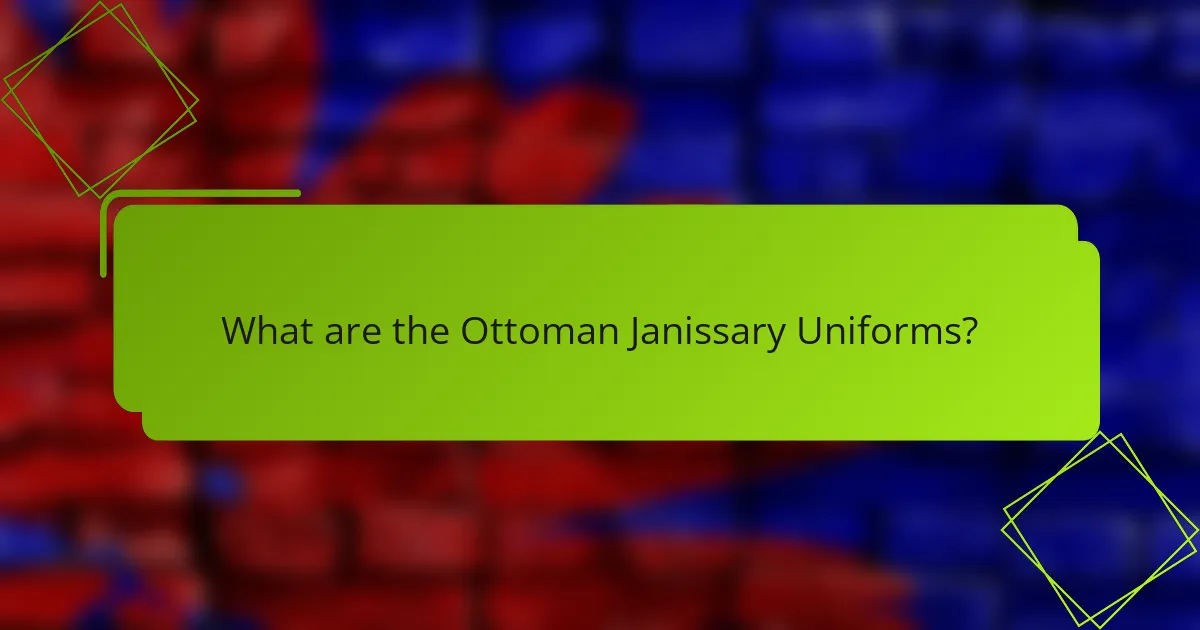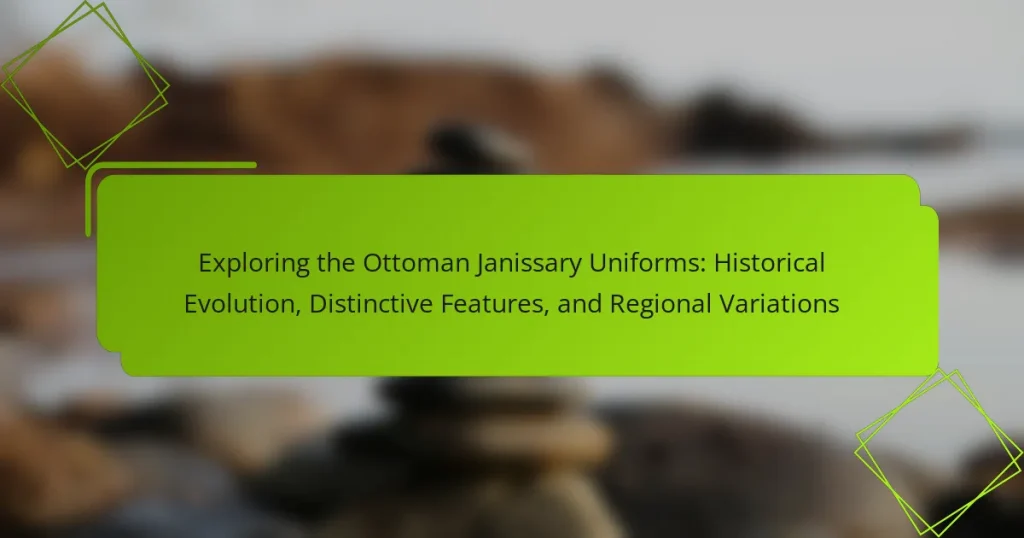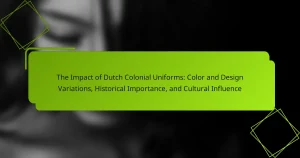Ottoman Janissary uniforms were the official attire of the elite military corps in the Ottoman Empire, characterized by their long kaftans, intricate embroidery, and vibrant colors. These uniforms evolved over time, influenced by changing military needs and cultural diversity, and became symbols of prestige and military identity. Key features included distinctive headgear known as borks and materials ranging from wool to silk, which indicated rank and function within the military hierarchy. The study of these uniforms reveals insights into the social structure, values, and historical identity of the Ottoman Empire, highlighting their role in fostering unity and recognition among the Janissaries.

What are the Ottoman Janissary Uniforms?
Ottoman Janissary uniforms were the distinctive clothing worn by the elite military corps of the Ottoman Empire. These uniforms evolved over time, reflecting changes in military fashion and cultural influences. The uniforms typically featured a long, flowing robe called a “kaftan.” They were often adorned with intricate embroidery and vibrant colors. Headgear included a distinctive felt hat known as a “bork.” The materials used ranged from wool to silk, depending on rank and occasion. Janissary uniforms symbolized prestige and military prowess. Historical records indicate that these uniforms were standardized by the 16th century.
How did the Janissary uniforms evolve over time?
Janissary uniforms evolved significantly from the 14th to the 19th century. Initially, they wore simple garments made of wool and cotton. These early uniforms were practical for battle and featured a basic design. Over time, the uniforms became more elaborate and colorful. By the 16th century, they included distinctive elements like the “bork” hat and long coats. The introduction of embroidery and rich fabrics marked a shift towards a ceremonial look. In the 18th century, military reforms influenced uniform styles, incorporating European elements. The final evolution in the 19th century saw the adoption of modern military attire. This transformation reflected changes in warfare and the Janissaries’ role within the Ottoman Empire.
What historical events influenced the design of Janissary uniforms?
The design of Janissary uniforms was influenced by several historical events. The establishment of the Janissary corps in the 14th century marked the beginning of their distinct military attire. The Ottoman Empire’s expansion into Europe introduced elements from various cultures, impacting uniform design. The Battle of Mohács in 1526 led to changes in military attire to reflect the empire’s growing power. The introduction of gunpowder weapons necessitated functional adaptations in uniforms for better mobility. Additionally, the influence of European military styles during the 17th century prompted further modifications. The eventual decline of the Janissary corps in the 19th century marked the end of traditional uniform designs. These events collectively shaped the evolution of Janissary uniforms throughout their history.
How did cultural exchanges shape the evolution of these uniforms?
Cultural exchanges significantly influenced the evolution of Ottoman Janissary uniforms. The incorporation of various textiles and designs from conquered regions is a clear example. For instance, Persian and Central Asian influences introduced intricate patterns and vibrant colors. Additionally, interactions with European military styles led to adaptations in cut and functionality. Historical records indicate that Janissaries adopted elements from the uniforms of neighboring cultures, enhancing their own attire. This blending of styles reflected the Ottomans’ diverse empire. The uniforms evolved as a symbol of both military prowess and cultural identity. Such exchanges fostered a dynamic evolution that showcased the empire’s global interactions.
What distinctive features characterize the Janissary uniforms?
Janissary uniforms are characterized by their distinctive colors, materials, and designs. They typically featured a long, flowing robe called a “kaftan.” The kaftan was often made from luxurious fabrics like silk or brocade. Bright colors such as red, blue, and green were commonly used. The uniforms also included a unique headgear known as the “bork,” which was a tall, cylindrical hat. This headgear distinguished Janissaries from other military units. Additionally, the uniforms included ornamental sashes and belts. These elements not only served functional purposes but also symbolized rank and status within the Janissary corps. Historical records indicate that the design of these uniforms evolved over time, reflecting changes in fashion and military needs.
What colors and materials were commonly used in Janissary uniforms?
Janissary uniforms commonly featured colors such as red, blue, and white. The predominant material used was wool, often combined with silk for decorative elements. Red symbolized bravery and blood, while blue represented loyalty. Wool provided durability and warmth, essential for military attire. The use of silk was prevalent in ornamental details like sashes and caps. Historical records indicate that these colors and materials were standardized during the 16th century. The vibrant colors also served to distinguish ranks within the Janissary corps.
How did the design of uniforms reflect the rank and role of the Janissaries?
The design of uniforms reflected the rank and role of the Janissaries through distinct colors, materials, and embellishments. Higher-ranking Janissaries wore more elaborate uniforms made from finer fabrics. These uniforms often featured rich colors such as red and gold, symbolizing their elevated status. In contrast, lower-ranking members donned simpler attire in more muted tones. The use of specific insignia and patterns also indicated rank and unit affiliation. For instance, unique headgear differentiated various roles within the Janissary corps. Overall, the uniform design served as a visual representation of hierarchy and function within the military structure.
What were the regional variations of Janissary uniforms?
Janissary uniforms exhibited regional variations influenced by local customs and materials. In Istanbul, the uniforms were often more elaborate, featuring intricate embroidery and vibrant colors. In contrast, uniforms from rural areas were simpler, using more durable fabrics suited for practical use. The use of different headgear also varied; for instance, the ‘bork’ was common in some regions while others favored the ‘fez.’ Additionally, local climate affected uniform design, with lighter materials used in warmer regions. Historical accounts indicate that these variations reflected the Janissaries’ adaptation to their specific environments and roles within the Ottoman military.
How did geography influence the design of uniforms in different regions?
Geography significantly influenced the design of uniforms in different regions by dictating materials and styles based on local resources and climate. For instance, regions with colder climates often utilized heavier fabrics for warmth. In contrast, warmer areas favored lighter materials to ensure comfort. The availability of specific dyes and textiles also shaped color choices and patterns. For example, the use of indigo was prevalent in regions where it was cultivated. Additionally, local cultural influences and military traditions impacted uniform design, leading to distinct variations. Historical records indicate that Ottoman Janissary uniforms evolved differently across the empire, reflecting regional characteristics.
What unique attributes can be found in Janissary uniforms from specific provinces?
Janissary uniforms from specific provinces exhibit unique attributes based on regional influences. For instance, uniforms from Istanbul often feature elaborate embroidery and vibrant colors, reflecting the capital’s status. In contrast, uniforms from the provinces of Anatolia may incorporate local fabrics and simpler designs. The use of distinctive headgear, such as the “bork” in some regions, also varies significantly. Additionally, certain provinces may include unique insignia or symbols representing local affiliations. These variations highlight the cultural diversity within the Janissary corps across the Ottoman Empire. Historical records indicate that these differences were not merely aesthetic but also served practical functions in identification and recruitment.

How did the Janissary uniforms impact military identity?
The Janissary uniforms significantly shaped military identity within the Ottoman Empire. These uniforms symbolized the elite status of the Janissaries as the empire’s core military force. Their distinctive attire included unique colors and designs, which fostered a sense of unity and pride among the soldiers. The uniforms also facilitated recognition on the battlefield, distinguishing Janissaries from other troops. This visual identity reinforced the Janissaries’ role as a professional military group. Historical records show that the uniforms evolved to reflect changing military needs and cultural influences. Over time, the attire became a representation of loyalty to the Sultan and the state. The uniforms ultimately contributed to the formation of a distinct military culture within the Ottoman Empire.
What role did uniforms play in the formation of Janissary identity?
Uniforms were crucial in shaping Janissary identity. They symbolized loyalty and discipline within the Ottoman military structure. The distinctive attire set Janissaries apart from other soldiers and civilians. Each uniform featured unique colors and designs that represented their elite status. The uniforms fostered a sense of unity and camaraderie among the Janissaries. They also served as a visual representation of the Ottoman Empire’s power. The use of specific materials and styles reflected the military’s prestige. Overall, uniforms were integral to the Janissary’s collective identity and societal role.
How did uniforms contribute to the perception of the Janissaries in society?
Uniforms significantly shaped the perception of the Janissaries in society. The distinctive attire symbolized their elite status within the Ottoman military. Bright colors and unique designs made them easily recognizable. This visibility fostered a sense of pride and authority among the Janissaries. Their uniforms also instilled fear in adversaries, reinforcing their reputation as formidable warriors. Additionally, the uniforms reflected the Janissaries’ loyalty to the Sultan. Over time, these garments became a symbol of the Ottoman Empire’s power. Historical records indicate that the uniforms evolved to reflect changing military needs and societal values.
What symbolic meanings were associated with Janissary uniforms?
Janissary uniforms symbolized loyalty, military prowess, and the power of the Ottoman Empire. The distinctive attire represented the elite status of the Janissaries within the military hierarchy. Colors and patterns in the uniforms often denoted rank and unit affiliation. The use of specific materials reflected the wealth and resources of the empire. Additionally, uniforms served to instill fear in enemies and project authority in conquered territories. Historical records indicate that uniforms were also a means of fostering unity among the troops. The visual impact of the uniforms contributed to the overall image of the Janissaries as formidable warriors.
How did colors and insignia reflect the values of the Janissary corps?
Colors and insignia of the Janissary corps symbolized their loyalty and military prowess. The distinctive colors, such as red and green, represented bravery and honor. Insignia included unique motifs that denoted rank and unit affiliation. These visual elements fostered unity and discipline among the Janissaries. The use of specific colors was also linked to the Islamic faith, reinforcing their commitment to the Sultan. Historical records indicate that these insignia were crucial for identification in battle. Overall, colors and insignia were integral in expressing the Janissaries’ values of loyalty, honor, and unity.
What rituals or traditions involved the wearing of these uniforms?
The rituals and traditions involving the wearing of Ottoman Janissary uniforms included ceremonial parades and military drills. These events showcased the uniforms’ distinctive features. The Janissaries wore their uniforms during religious ceremonies, emphasizing their role as elite soldiers. The uniforms symbolized loyalty to the Sultan and the empire. Special occasions, such as the annual circumcision festival, featured the Janissaries in full regalia. This highlighted their importance in cultural and military contexts. Historical records indicate that the uniforms were also worn during public celebrations and military campaigns. These traditions reinforced the Janissaries’ status within Ottoman society.

What can we learn from the study of Janissary uniforms today?
The study of Janissary uniforms today reveals insights into the cultural and military history of the Ottoman Empire. These uniforms reflect the evolution of military attire over centuries. They showcase the integration of various cultural influences, highlighting the Ottoman Empire’s diversity. The distinctive features of the uniforms, such as color and ornamentation, indicate rank and function within the military hierarchy. Analyzing these uniforms helps us understand the social structure and values of the time. Additionally, the materials used in the uniforms provide information about trade and resources available during the Ottoman period. Overall, Janissary uniforms serve as a visual representation of historical identity and military organization.
How can the historical significance of Janissary uniforms inform modern military attire?
The historical significance of Janissary uniforms can inform modern military attire by showcasing the evolution of functional design and symbolism. Janissary uniforms were designed for both practicality and representation of status. The use of distinct colors and patterns communicated rank and unit affiliation. This practice can inspire modern militaries to incorporate identifiable elements in their uniforms for cohesion and morale. Additionally, Janissary attire emphasized mobility and comfort, which are essential in contemporary military gear. The blend of aesthetic and functional attributes in Janissary uniforms highlights the importance of balancing tradition with modern needs in military design. This historical context can guide current military fashion towards effective and meaningful uniform choices.
What lessons can contemporary military forces draw from Janissary uniform designs?
Contemporary military forces can learn about the importance of uniform design from Janissary uniforms. Janissary uniforms were not only functional but also symbolically significant. They used vibrant colors and distinctive patterns to convey identity and rank. This practice can inform modern military forces about the value of visual distinction in fostering unit cohesion. The Janissaries also incorporated practical elements like ease of movement and weather resistance in their designs. Such considerations are vital for contemporary military apparel. Additionally, the historical adaptability of Janissary uniforms to various contexts highlights the need for modern forces to remain flexible in their uniform designs. Overall, the Janissary uniforms exemplify a blend of functionality, symbolism, and adaptability that can enhance contemporary military uniform strategies.
What practical insights can be gained from the Janissary uniform evolution?
The evolution of Janissary uniforms provides insights into military adaptation and cultural identity. Changes in materials reflected advancements in textile technology. Variations in design indicated shifts in military strategy and social status. The incorporation of specific colors and insignia revealed the influence of Ottoman symbolism. Uniform evolution also showcased regional adaptations based on local resources and climate. Historical records demonstrate how these uniforms affected troop morale and cohesion. The transition from traditional attire to standardized uniforms marked a significant military modernization. Overall, the Janissary uniform evolution illustrates the intersection of practicality, culture, and military effectiveness.
How can understanding historical uniforms enhance modern uniform design processes?
Understanding historical uniforms informs modern uniform design by providing insights into functionality, aesthetics, and cultural significance. Historical uniforms, such as the Ottoman Janissary uniforms, showcase practical elements that enhance mobility and comfort. These designs often reflect the technological advancements of their time, which can inspire modern innovations.
Additionally, examining the color schemes and materials used in historical uniforms helps designers create visually appealing and contextually appropriate modern uniforms. Historical uniforms also carry cultural narratives that can be integrated into contemporary designs, fostering a sense of identity and continuity.
The Janissary uniforms, for example, featured distinctive patterns and colors that represented their elite status. By studying these characteristics, modern designers can develop uniforms that honor tradition while meeting current needs. This blend of history and modernity can lead to uniforms that are not only functional but also resonate with wearers on a deeper level.
What best practices can be applied from the Janissary uniform legacy?
The best practices that can be applied from the Janissary uniform legacy include the emphasis on distinct identity and functionality. Janissary uniforms were designed to reflect the military hierarchy and role. This approach can be used in modern uniforms to enhance organizational identity. The use of specific colors and symbols in Janissary attire fostered unity and morale among troops. Incorporating similar elements in contemporary uniforms can promote cohesion. Additionally, the Janissary’s adaptation of materials for practicality can inform modern design for comfort and durability. Historical records show that these uniforms were both practical and symbolic, which can guide current uniform design principles.
The main entity of the article is the Ottoman Janissary uniforms, which were the distinctive clothing worn by the elite military corps of the Ottoman Empire. The article explores the historical evolution of these uniforms from the 14th to the 19th century, highlighting their distinctive features, such as the kaftan and bork hat, as well as the colors and materials used. It discusses the impact of historical events and cultural exchanges on uniform design, regional variations influenced by geography, and the symbolic meanings associated with the attire. Additionally, the article examines how these uniforms shaped military identity and their relevance to modern military design practices.




